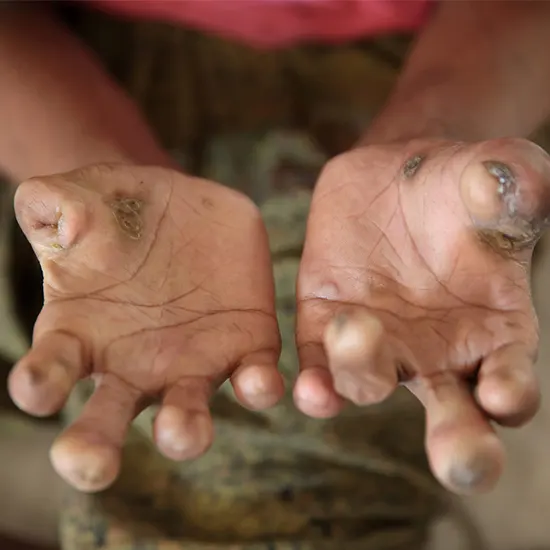
Mycobacterium leprae, which sometimes goes by the name Hansen's disease, is the bacterium that causes the chronic infectious illness known as leprosy. Although it mostly affects the skin and peripheral nerves, it can also...
Mycobacterium leprae, which sometimes goes by the name Hansen's disease, is the bacterium that causes the chronic infectious illness known as leprosy. Although it mostly affects the skin and peripheral nerves, it can also harm the eyes, respiratory system, and bones.
Contact with nasal secretions or droplets from an infected individual can transmit leprosy. It may be treated with a mix of antibiotics and is not very infectious.
Leprosy is a treatable condition, but in order to avoid future problems, early identification and treatment are crucial. It can permanently harm the skin, nerves, limbs, and eyes if left untreated.
Leprosy was long seen to be a highly stigmatised illness, and persons who had it were frequently shunned and rejected by their communities. However, because to advancements in medical care, leprosy is no longer as stigmatised, and most nations have laws protecting the rights of those who are afflicted.
Leprosy Through the Ages: Tracing the History of a Stigmatized Disease
Leprosy has a lengthy and complicated past that dates back to antiquity. The sickness was known to the ancient Egyptians, Greeks, and Romans, and it has been recorded in several ancient sources, including the Bible.
Leprosy was extensively feared and stigmatised throughout Europe during the Middle Ages.
In leprosy institutions, also known as leprosaria, leprosy patients were frequently required to wear specific KFT clothing and were isolated from the general population. Additionally connected to sin, the illness was seen as God's retribution for sin.
Leprosy was brought to many regions of the world throughout the colonial era, including Asia, Africa, and the Americas. People with leprosy were frequently forcibly abducted from their families and villages and imprisoned X-Ray in these hospitals for life as a result of leprosy hospitals being constructed in these areas by European colonial powers.
Effective leprosy therapies, including antibiotics like dapsone and rifampicin, were created in the 20th century. The sickness was curable and could not spread thanks to these therapies.
Even while leprosy is far less prevalent than it once was, it nevertheless poses a serious threat to public LFT health in several regions of the world, notably in Brazil, India, and other nations in Asia, Africa, and Latin America.
Leprosy: Examining the Physical Characteristics of the Bacillus
Mycobacterium leprae, an acid-fast bacillus (AFB), is the culprit behind leprosy.
- The bacilli are rod-shaped and range in length from 1 to 8 micrometres.
- The condition typically affects the nasal mucosa, skin, and superficial nerves.
- From paucibacillary forms with few skin lesions and little nerve involvement to multibacillary forms with many skin lesions and extensive nerve involvement, leprosy exhibits a wide spectrum of clinical symptoms.
- Hypopigmented or erythematous plaques, nodules, or papules are the most common types of skin lesions. They can come with sensory loss, hair loss, and swollen nerves.
- Leprosy in advanced stages can cause nerve damage and physical abnormalities like claw hands and foot drop.
The Life Cycle of Leprosy: A Tale of Intrigue and Survival
The bacteria Mycobacterium leprae, which causes leprosy, has a convoluted life cycle. The following are some key aspects of the leprosy life cycle:
- When an infected individual coughs or sneezes, the bacteria is transferred from person to person by respiratory droplets.
- The bacteria enters the body after being breathed and infects immune cells called macrophages.
- Following this, the bacteria multiplies inside the macrophages and spreads to adjacent neurons and other tissues, causing tissue death and nerve damage.
- Leprosy has a lengthy incubation period, lasting anywhere from six months to more than five years. During this time, the illness may be asymptomatic or show vague signs.
If untreated, leprosy has a protracted, chronic course and can last for many years or even decades.
The Many Faces of Leprosy: An Overview of Its Different Types
Based on the quantity of bacteria present in the body and the patient's immunological reaction to the infection, leprosy is divided into two basic categories. These kinds include-
|
|
Paucibacillary Leprosy |
Multibacillary Leprosy |
|
Bacterial Load |
Low (fewer than 5 bacilli) |
High (numerous bacilli) |
|
Skin Lesions |
Well-defined |
Poorly-defined |
|
Sensation in Lesions |
Loss of sensation |
No loss of sensation |
|
Nerve Damage |
Limited |
Widespread |
|
Immune Response |
Good |
Poor |
|
Treatment Regimen |
Short term (6 months) |
Long-term (12-24 months) |
|
Risk of transmission |
Low |
High |
|
Complications |
Few |
Severe |
There are intermediate forms of leprosy, which share traits with both paucibacillary and multibacillary leprosy, in addition to these two primary varieties. Examples include borderline tuberculoid, borderline lepromatous, and borderline borderline. Leprosy categorization is crucial for figuring out the best treatment plan, as well as the risk of complications and transmission.
The Leprosy Infection: A Comprehensive Overview of the Disease
The bacterium Mycobacterium leprae is the source of leprosy infection, which has a protracted, chronic course and a range of clinical symptoms. The following are some key signs of leprosy infection:
- Leprosy can also be spread through contact with contaminated objects or by respiratory droplets produced when an infected person coughs or sneezes.
- The bacteria enters the body through the nose and infects macrophages, a kind of immune cell vital to warding off illness.
- Additionally, the bacteria has the ability to infect Schwann cells, the cells that protect and cushion neurons, causing damage to the nerves and loss of feeling.
- The incubation period for leprosy is lengthy and can last anywhere between six months and more than five years.
- Leprosy patients' immunological responses to the illness and the body's bacterial burden both influence how the disease manifests clinically.
- Skin sores, nerve damage, and muscular weakness are some of the symptoms of leprosy that, if ignored, can result in deformities and disabilities.
- Depending on the number of bacteria present in the body and the patient's immune response, leprosy severity can be categorised as paucibacillary or multibacillary.
From Signs to Solutions: A Comprehensive Guide to Leprosy Diagnosis
Leprosy is diagnosed using a mix of clinical, histological, and bacterial techniques. Here are a few of the typical techniques for leprosy diagnosis:
Clinical examination
Based on the recognisable skin lesions and nerve involvement, a dermatologist or skilled healthcare professional can identify leprosy. Early instances often present as hypopigmented or CECT Chest erythematous plaques with sensory loss, but more advanced cases may present with nodules and swollen nerves.
Histopathological evaluation
A skin sample from the lesion can be collected and studied under a microscope to check for the presence of granulomas and acid-fast bacilli (AFB). Leprosy may be distinguished from other skin conditions using the histological analysis.
Bacteriological analysis
To identify the presence of AFB, a skin smear or biopsy sample can be stained with the Ziehl-Neelsen stain and inspected under a microscope. The presence of AFB supports the leprosy diagnosis.
Culture
The bacteria must be cultured, which takes time and effort and is not done frequently.
Immunological tests
These exams look for antibodies to M. leprae in the CBC skin or blood. Although they are not frequently utilised for diagnosis, they can be useful for research studies and early case detection.
It is crucial to remember that a qualified healthcare provider with experience in the diagnosis and treatment of leprosy should make the leprosy diagnosis. The prevention of impairments and deformities requires early identification and treatment.
Defeating Leprosy: Understanding Treatment Options for the Disease
The duration and course of leprosy therapy are determined by the kind and severity of the disease and require the use of medicines to eradicate the bacteria that cause the illness.
The standard treatment for leprosy, multidrug therapy (MDT), which entails a mix of drugs, has been recommended by the World Health Organisation (WHO). The following are some of the typical antibiotics used to treat leprosy:
Dapsone
Dapsone is a bacteriostatic antibiotic that prevents Mycobacterium leprae from proliferating. A milder variant of the illness called paucibacillary leprosy is treated with it.
Rifampicin
Rifampicin is a bactericidal antibiotic that works by preventing DNA-dependent RNA polymerase from growing bacteria. Treatment for both paucibacillary and multibacillary infections uses it.
Clofazimine
A bactericidal antibiotic with anti-inflammatory qualities is clofazimine. Treatment for multibacillary leprosy involves it.
The type of leprosy and the amount of germs in the patient's body determine how long the therapy will take. Dapsone and rifampicin are used to treat paucibacillary leprosy for 6 months, whereas a combination of dapsone, rifampicin, and clofazimine is used to treat multibacillary leprosy for 12 to 24 months.
To avoid deformities and impairments, patients may also get supportive treatment in addition to antibiotics, such as wound care and physical therapy. Early leprosy diagnosis and treatment are essential for preventing more nerve damage and impairment as well as for lowering the chance of the illness spreading.
Leprosy is curable - let's spread awareness and fight back









